By: Dylan Jones, Part 2 of 2
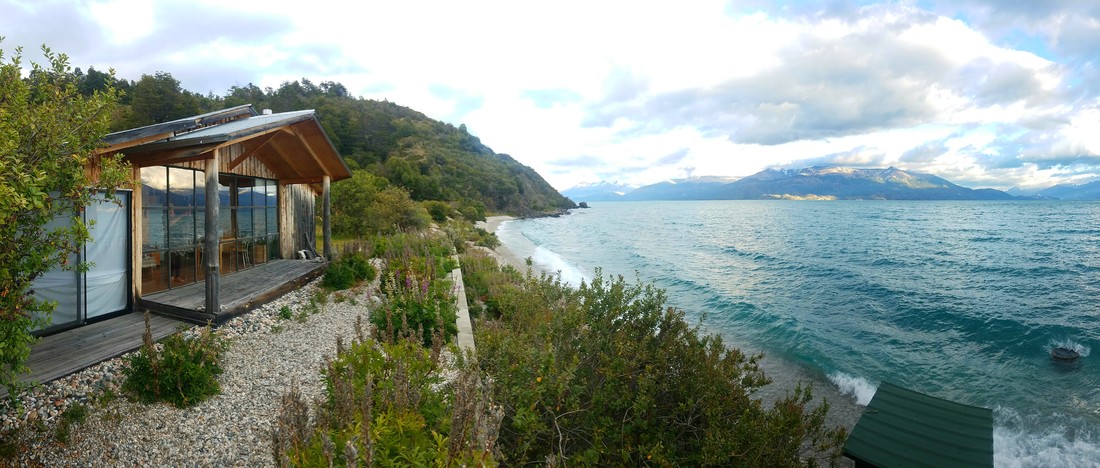
Cabin on Lago General Carrera, PC: Dylan Jones
I wake up at 6:00 a.m., comfortable in my sleeping bag despite the stiff bed. I take a deep breath and smell the coffee. Although our expedition in the Patagonian backcountry is complete, Nadine maintains her role as early riser and team chef. I stumble out into the living room and rub my eyes. The incredible scene comes into focus through floor-to-ceiling windows: Frothy waves lap at a pebble beach several meters from the porch. Undulating turquoise waters influenced by dynamic winds extend for tens of miles, walled in by the imposing peaks of the Northern Patagonian Ice Field.
Patagonia Sin Represas
We are fortunate to be eating breakfast in a lovely cabin on Lago General Carrera. With a surface area of 714 square miles (602 of which are in the Aysén Region), the glacial lake is Chile’s largest. It drains west to the Pacific via Rio Baker, one of the world’s premier class V whitewater runs. Originally scheduled to be tamed by two controversial mega-dams, the Baker was saved in 2015 following a successful campaign by grassroots river advocacy group Patagonia Sin Represas.
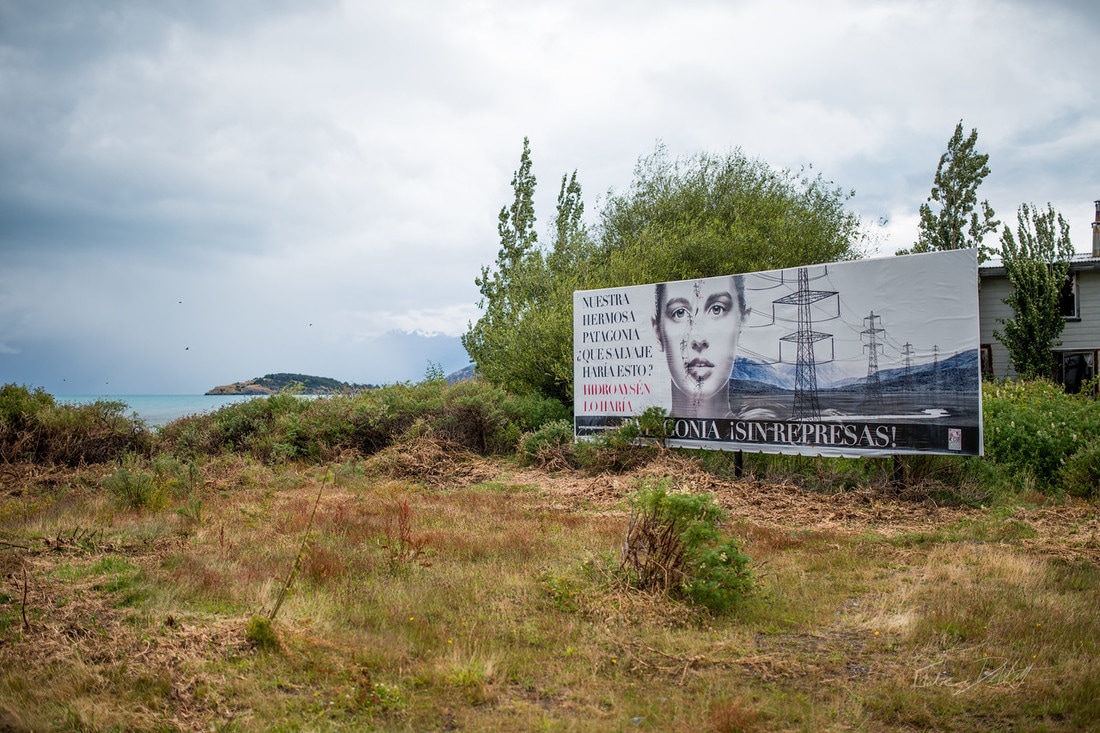
Patagonia Sin Represas/Patagonia without dams, PC: Gabe DeWitt
According to International Rivers, Patagonia Sin Represas “became the largest environmental struggle in the country’s history. The tireless efforts of river defenders in Chile and around the world helped create massive popular opposition to HidroAysén—both within Chile and abroad—which eventually led to the project being cancelled. HidroAysén proposed to build three dams on the Pascua River and two dams on the Baker River in the Aysén region of southern Chile. The dams would have flooded nearly 15,000 acres of globally rare forest ecosystems and some of the most productive agricultural land in the area.”
Patagonia Sin Represas was featured in 180 Degrees South, the 2010 adventure film that follows Jeff Johnson as he retraces the footsteps of Doug Tompkins and Yvon Chouinard during their legendary 1968 journey through Patagonia to climb Mount Fitz Roy. On our trip into Parque Patagonia, we passed an anti-dam billboard outside the lakeside town of Puerto Rio Tranquilo that was erected during the height of the campaign. After learning the details from Nadine, who had participated in several protests, it was uplifting to see the message in the wake of the major environmental victory.
Big Land, Small World
Although Patagonia covers over 400,000 square miles, its ardent supporters live in a small world. Our cabin on Lago General Carrera belongs to Lito Tejada-Flores, one of the mountaineers who accompanied Tompkins and Chouinard on the ‘68 Fitz Roy climb. Nadine was the former executive director of Conservacion Patagonica, the land conservation organization donating Parque Patagonia to Chile. Conservacion Patagonica was founded in 2000 by Doug Tompkins and his wife, Kristine McDivitt Tompkins. Like the water cycle, the Patagonian connections came full circle.
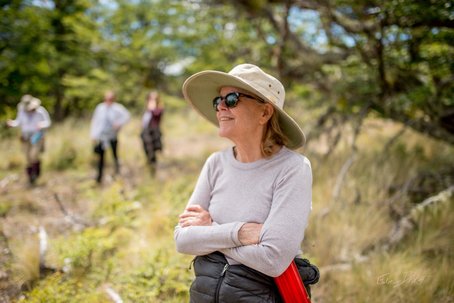
Kristine Tompkins, PC: Gabe DeWitt
Life is also cyclical. Doug Tompkins’s life came to a sudden close on December 8, 2015, in a kayaking accident on Lago General Carrera, when he died from hypothermia after his kayak capsized in a large swell. Doug’s tragic passing sent shockwaves through the adventure and conservation communities. Intimately close with the Tompkins, Nadine’s standard tone of optimism turned solemn when discussing Doug’s death.
The Southern Way
Lago General Carrera is circumnavigated by the Carretera Austral, Chile’s Southern Highway that’s considered one of the world’s great road trips. A product of the Pinochet Regime, CH-7 was commenced in 1976, opened to traffic in 1988, and completed in 2003. Nearly 800 miles long, the epic highway provides access to about 100,000 Chileans from Puerto Montt in the north to its southern terminus of Caleta Tortel. We rented a 4×4 and drove nearly 200 miles from the Balmaceda airport to the park in Valle Chacabuco.
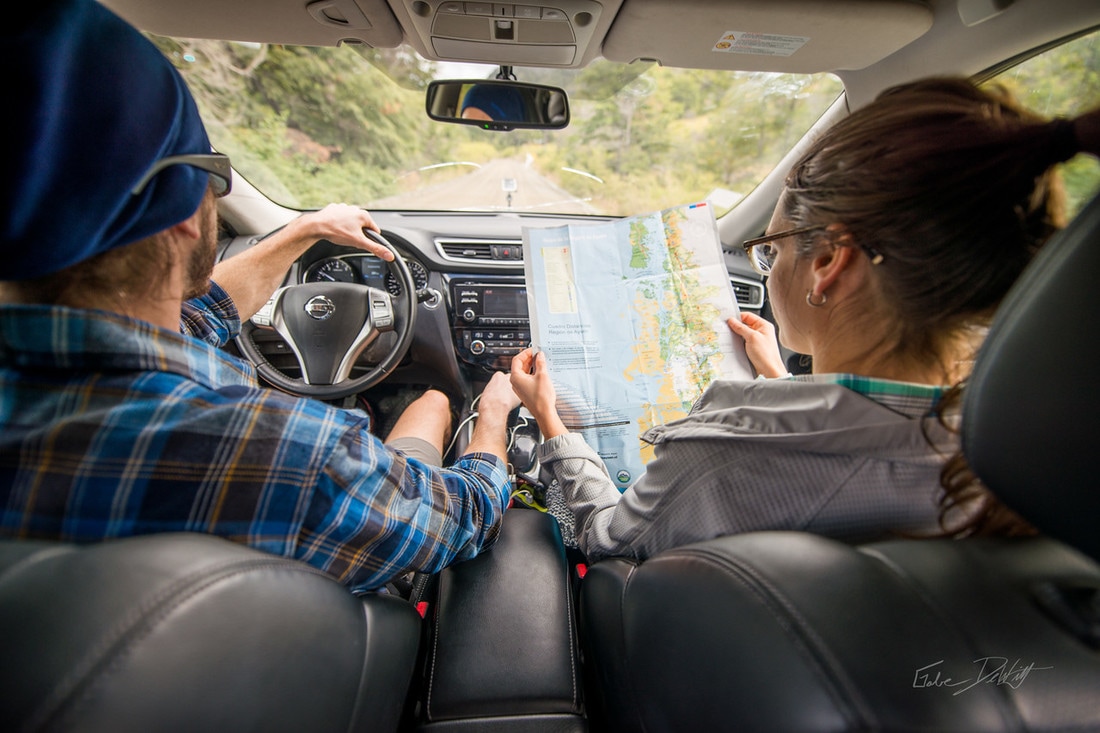
Dylan Jones and Samantha Larson navigate the Carretera Austral, PC: Gabe DeWitt
Mostly gravel with a few paved sections, the highway is littered with potholes, stacked with hairpin turns, and plagued by steep drop offs with few guardrails. Makeshift memorials to those who lost their lives in accidents dot the highway, small shrines with flowers and piles of plastic bottles presented to Deolinda, the saint of all travelers. Passing tens of these shrines with hundreds of bottles, I couldn’t help but think of microplastics.
A Drop in the Bucket
At its southern end, Lago General Carrera flows into Lago Bertrand; the Rio Baker originates from Betrand’s southern tip. The bottleneck at the confluence of the two glacial lakes is spanned by Puente General Carrera, a bright orange suspension bridge that contrasts the brilliant blue hue of the water beneath its grated deck.
Considering all the liquid water exiting Lago Genera Carrera on its way to the Pacific eventually flows under this bridge, I decide this should be my second sample site. On the gravel shore, a fire ring filled with charcoal and tin cans serve as evidence of past travelers who frequented the idyllic site. Fishing line is strewn about, wrapped around various twigs and bridge components, the free ends floating in the incessant surface winds.
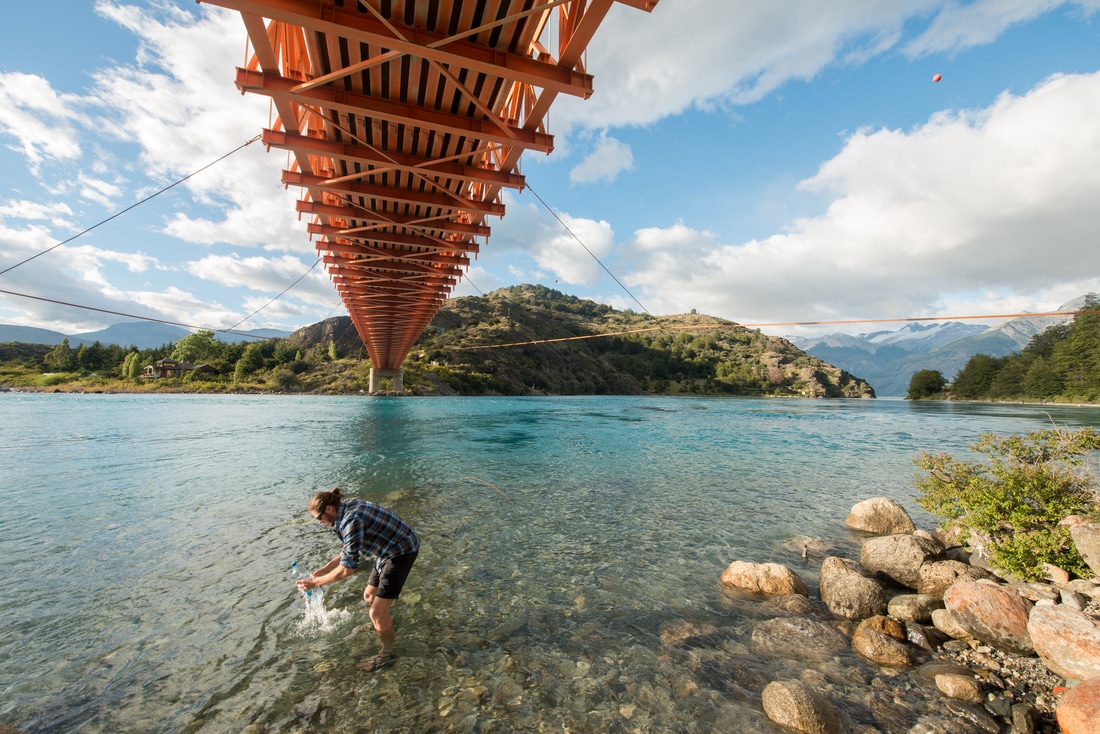
Dylan Jones collect a microplastic water sample in the Rio Baker, PC: Gabe DeWitt
My ankles go numb as I rinse the bottle a third time. I take a deep breath as my hands follow suit when I submerge the bottle for the sample; bubbles rise as the air from the Jeinimeni mountains is replaced with water that will journey to Maine. Numb extremities are a small price to pay for science.
Into the Horizon
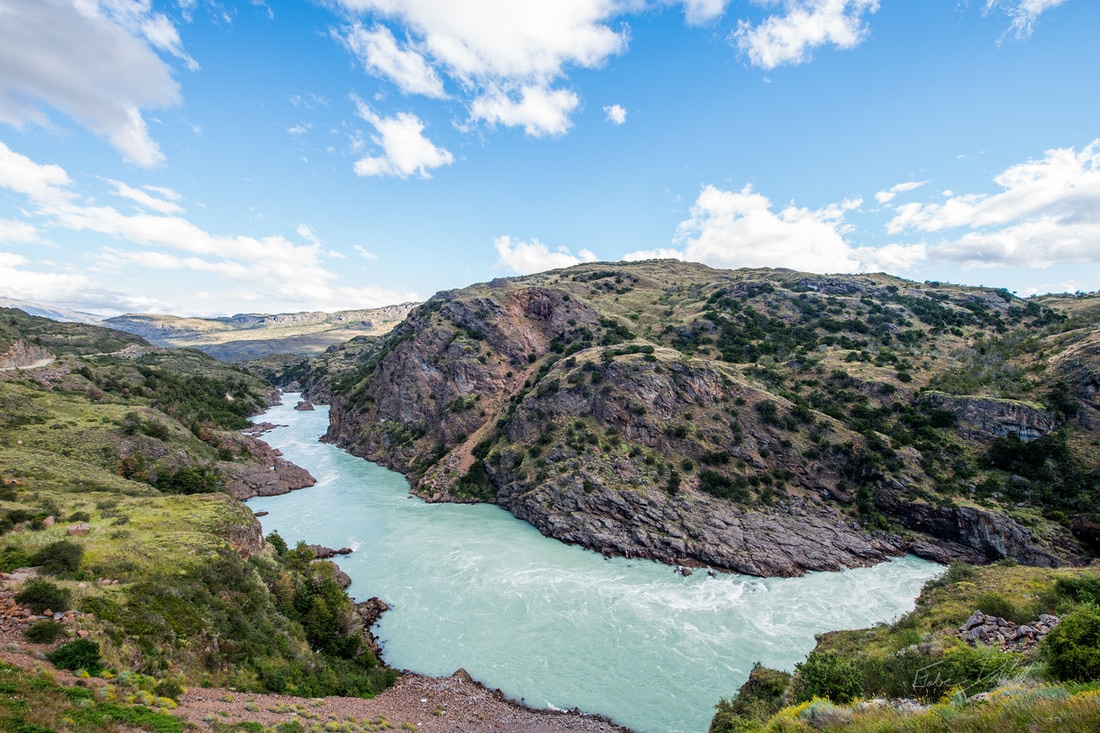
The Rio Baker, PC: Gabe DeWitt
As we rumble back to Balmaceda, I catch my final glimpse of Lago General Carrera. Its vastness makes it seem as if you’ll be able to see it forever, but even the grandest landscapes eventually fade into the horizon. As the last glimmer of turquoise dips behind the verdant hills, I think about Doug Tompkins.
His legacy lives on through the millions of pristine acres he and Kristine have preserved through Conservacion Patagonia. We were fortunate to cross paths with Kristine and her family while hiking Circuito Lago Chico, one of Kristine’s favorite hikes in Parque Patagonia . The euphoria I felt in her presence was accompanied by sorrow—I couldn’t shake the feeling that Doug should have been standing there beside her. But after spending a week becoming intimate with Kristine’s favorite landscape, I feel as though I met Doug Tompkins that day.
Source: https://www.internationalrivers.org/campaigns/patagonia-sin-represas
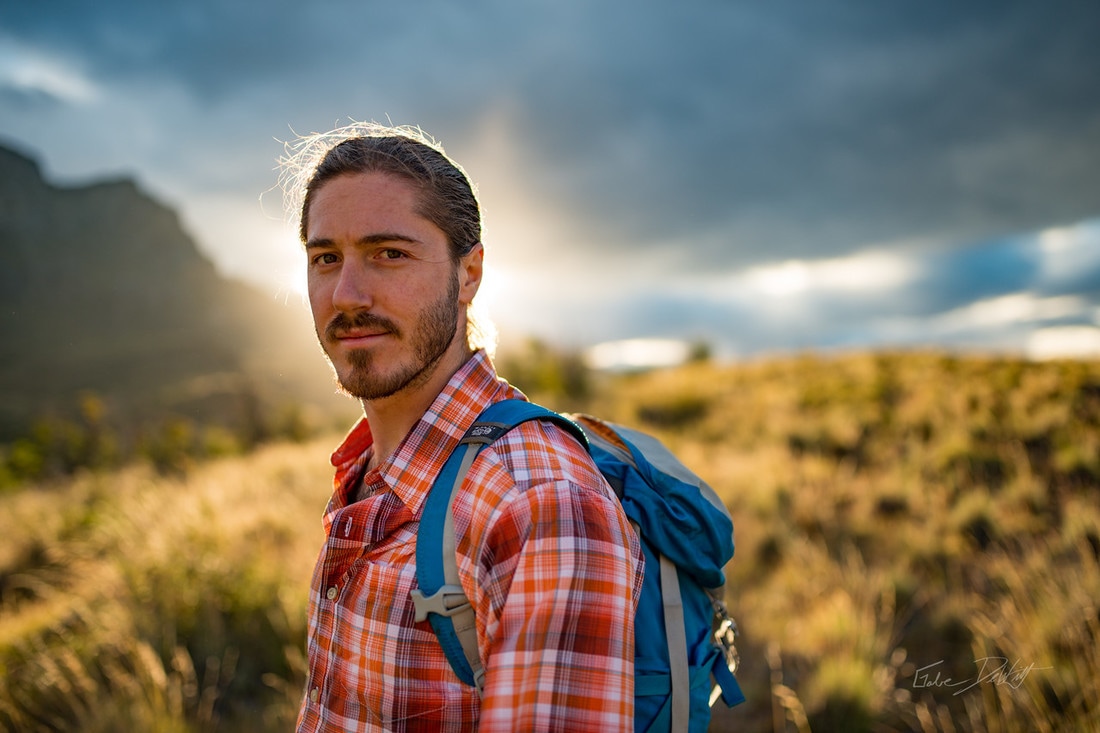
PC: Gabe DeWitt
|
Dylan Jones is a writer and photographer based in the mountains of West Virginia. He has collected data for Adventure Scientists in the American West, Thailand, Costa Rica, and Chile. He is managing editor of Highland Outdoors and a regular contributor to RootsRated. Dylan holds a bachelor’s degree in journalism and a master’s degree in public administration, both from West Virginia University.
|







